Radiator Hyundai Getz 2004 User Guide
[x] Cancel search | Manufacturer: HYUNDAI, Model Year: 2004, Model line: Getz, Model: Hyundai Getz 2004Pages: 445, PDF Size: 12.16 MB
Page 200 of 445
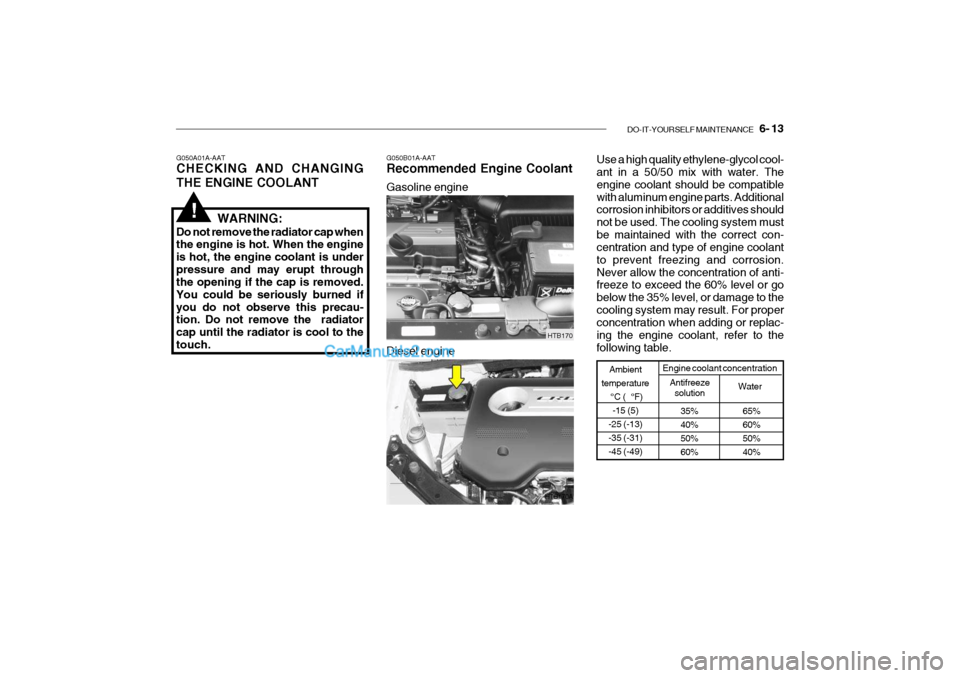
DO-IT-YOURSELF MAINTENANCE 6- 13
HTB170
HTB170A
Gasoline engine Diesel engine
G050A01A-AAT CHECKING AND CHANGING THE ENGINE COOLANT
G050B01A-AAT Recommended Engine Coolant
Use a high quality ethylene-glycol cool- ant in a 50/50 mix with water. The engine coolant should be compatiblewith aluminum engine parts. Additional corrosion inhibitors or additives should not be used. The cooling system mustbe maintained with the correct con- centration and type of engine coolant to prevent freezing and corrosion.Never allow the concentration of anti- freeze to exceed the 60% level or go below the 35% level, or damage to thecooling system may result. For proper concentration when adding or replac- ing the engine coolant, refer to thefollowing table.
WARNING:
Do not remove the radiator cap when the engine is hot. When the engine is hot, the engine coolant is underpressure and may erupt through the opening if the cap is removed. You could be seriously burned ifyou do not observe this precau- tion. Do not remove the radiator cap until the radiator is cool to thetouch.
!
35% 40%50%60%
Ambient
temperature °C ( °F)-15 (5)
-25 (-13)-35 (-31)-45 (-49)
Antifreeze solution Water
Engine coolant concentration
65% 60%50%40%
Page 201 of 445
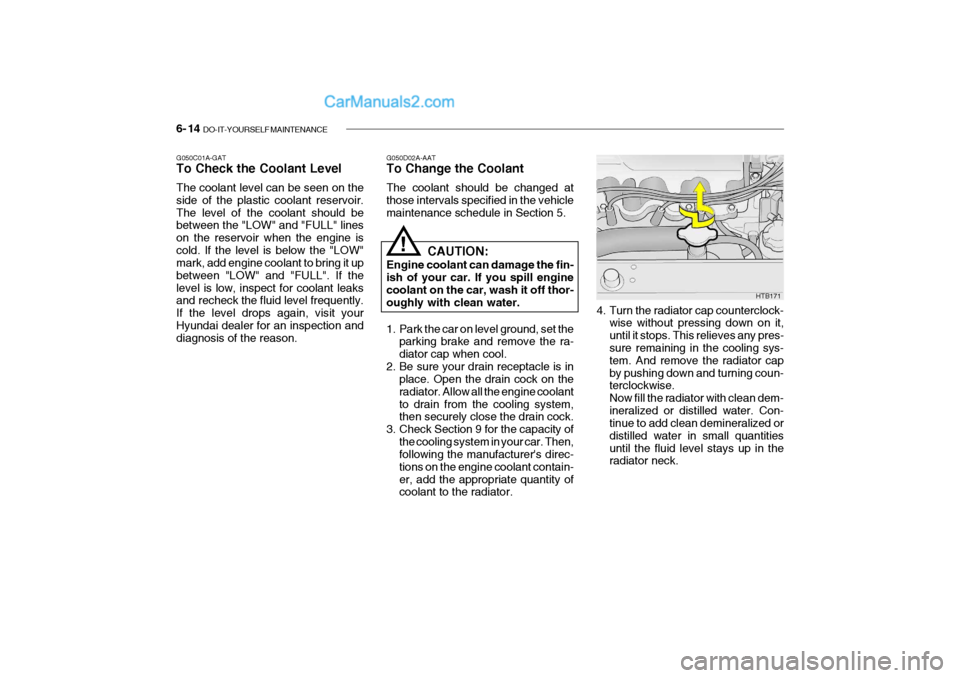
6- 14 DO-IT-YOURSELF MAINTENANCE
HTB171
G050C01A-GAT To Check the Coolant Level The coolant level can be seen on the side of the plastic coolant reservoir.The level of the coolant should be between the "LOW" and "FULL" lines on the reservoir when the engine iscold. If the level is below the "LOW" mark, add engine coolant to bring it up between "LOW" and "FULL". If thelevel is low, inspect for coolant leaks and recheck the fluid level frequently. If the level drops again, visit yourHyundai dealer for an inspection and diagnosis of the reason. G050D02A-AAT To Change the Coolant The coolant should be changed at those intervals specified in the vehiclemaintenance schedule in Section 5.
CAUTION:
Engine coolant can damage the fin-ish of your car. If you spill engine coolant on the car, wash it off thor- oughly with clean water.
!
1. Park the car on level ground, set the parking brake and remove the ra- diator cap when cool.
2. Be sure your drain receptacle is in place. Open the drain cock on theradiator. Allow all the engine coolantto drain from the cooling system, then securely close the drain cock.
3. Check Section 9 for the capacity of
the cooling system in your car. Then,following the manufacturer's direc- tions on the engine coolant contain-er, add the appropriate quantity of coolant to the radiator. 4. Turn the radiator cap counterclock-
wise without pressing down on it, until it stops. This relieves any pres- sure remaining in the cooling sys- tem. And remove the radiator capby pushing down and turning coun- terclockwise. Now fill the radiator with clean dem-ineralized or distilled water. Con- tinue to add clean demineralized or distilled water in small quantitiesuntil the fluid level stays up in the radiator neck.
Page 202 of 445

DO-IT-YOURSELF MAINTENANCE 6- 15
HTB172
5. Start the engine, top off the radiator with water and then add engine coolant to the reservoir until the level is between "LOW" and "FULL".
6. Replace the radiator and reservoir caps and check to be sure the draincocks are fully closed and not leak-ing.
WARNING:
The cooling fan is controlled byengine coolant temperature and may sometimes operate even when the engine is not running. Use ex-treme caution when working near the blades of the cooling fan so that you are not injured by a rotating fan blade. As the engine coolant tem-perature decreases, the fan will au- tomatically shut off. This is a nor- mal condition.
!
G060B02S-GAT REPLACING THE SPARK PLUGS
CHAMPION NGK
RC10YC BKR5ES
Unleaded
engine Leaded
engine
RC10YC4 BKR5ES-11
G060A01L
Unleaded: 1.0 ~ 1.1 mm (0.039 ~ 0.043 in.) Leaded: 0.7 ~ 0.8 mm(0.028 ~ 0.032 in.)
The spark plugs should be changed at the intervals specified in the vehicle maintenances schedule in Section 5 or whenever engine performance indi-cates they should be changed. Symp- toms that suggest poor spark plug performance include engine misfiringunder load, loss of fuel economy, poor acceleration, etc. When spark plugs are replaced, always use spark plugs recommended by Hyundai. The use ofother spark plugs can result in loss of performance, radio interference or engine damage. NOTE: When replacing the spark plugs, always use genuine parts recom-mended. Recommended Spark Plugs:
Page 205 of 445
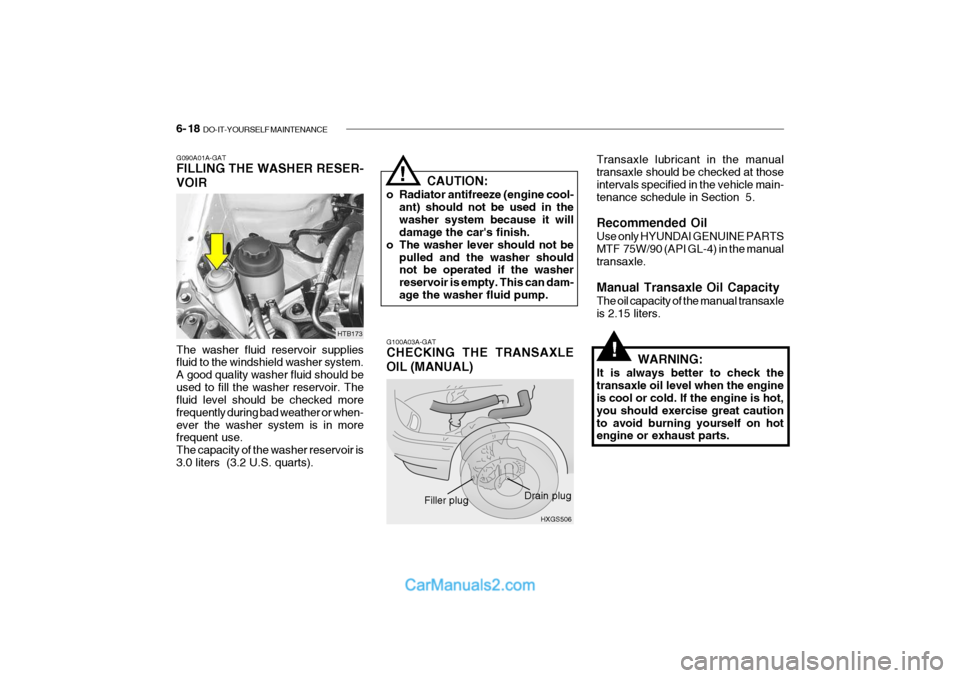
6- 18 DO-IT-YOURSELF MAINTENANCE
G100A03A-GAT CHECKING THE TRANSAXLE OIL (MANUAL)
G090A01A-GAT FILLING THE WASHER RESER- VOIR The washer fluid reservoir supplies fluid to the windshield washer system. A good quality washer fluid should beused to fill the washer reservoir. The fluid level should be checked more frequently during bad weather or when-ever the washer system is in more frequent use. The capacity of the washer reservoir is3.0 liters (3.2 U.S. quarts). CAUTION:
o Radiator antifreeze (engine cool- ant) should not be used in thewasher system because it will damage the car's finish.
o The washer lever should not be pulled and the washer shouldnot be operated if the washer reservoir is empty. This can dam-age the washer fluid pump.
!
HTB173
HXGS506
Drain plug
Filler plug
Transaxle lubricant in the manual transaxle should be checked at those intervals specified in the vehicle main-tenance schedule in Section 5. Recommended Oil Use only HYUNDAI GENUINE PARTS MTF 75W/90 (API GL-4) in the manual transaxle. Manual Transaxle Oil Capacity The oil capacity of the manual transaxle is 2.15 liters.
WARNING:
It is always better to check thetransaxle oil level when the engine is cool or cold. If the engine is hot, you should exercise great cautionto avoid burning yourself on hot engine or exhaust parts.
!
Page 206 of 445
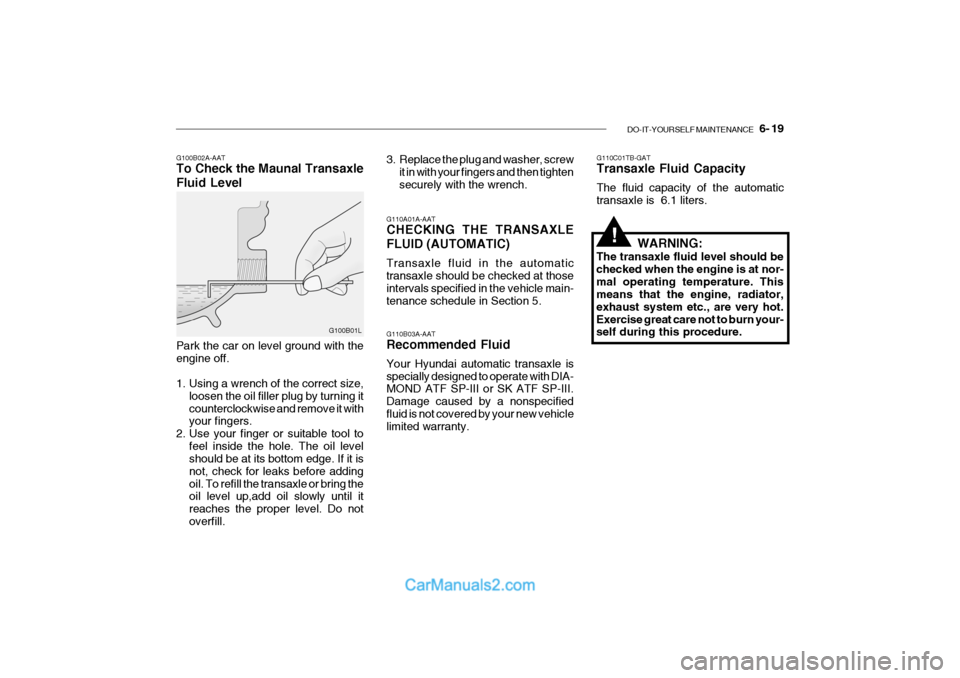
DO-IT-YOURSELF MAINTENANCE 6- 19
G100B02A-AAT To Check the Maunal Transaxle Fluid Level
G110A01A-AAT CHECKING THE TRANSAXLE FLUID (AUTOMATIC) Transaxle fluid in the automatic transaxle should be checked at those intervals specified in the vehicle main-tenance schedule in Section 5. G110B03A-AAT Recommended Fluid Your Hyundai automatic transaxle is specially designed to operate with DIA-
MOND ATF SP-III or SK ATF SP-III. Damage caused by a nonspecifiedfluid is not covered by your new vehicle limited warranty.G110C01TB-GAT Transaxle Fluid Capacity The fluid capacity of the automatic transaxle is 6.1 liters.
G100B01L
Park the car on level ground with the engine off.
1. Using a wrench of the correct size, loosen the oil filler plug by turning it counterclockwise and remove it with your fingers.
2. Use your finger or suitable tool to feel inside the hole. The oil levelshould be at its bottom edge. If it is not, check for leaks before addingoil. To refill the transaxle or bring the oil level up,add oil slowly until it reaches the proper level. Do notoverfill. 3. Replace the plug and washer, screw
it in with your fingers and then tightensecurely with the wrench.
WARNING:
The transaxle fluid level should bechecked when the engine is at nor-mal operating temperature. This means that the engine, radiator, exhaust system etc., are very hot.Exercise great care not to burn your- self during this procedure.
!
Page 209 of 445
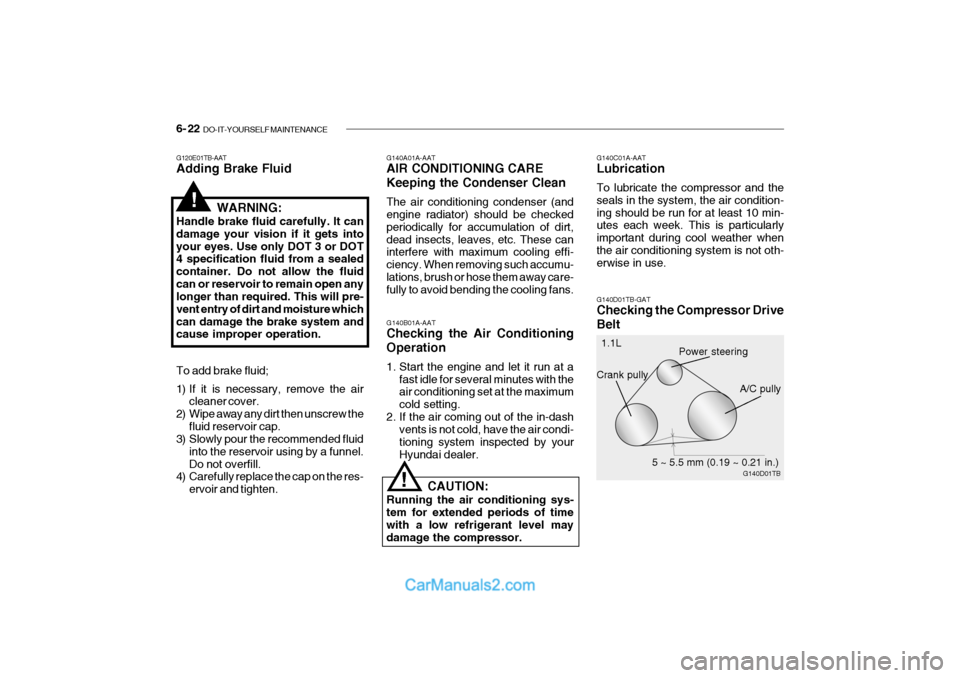
6- 22 DO-IT-YOURSELF MAINTENANCE
G140A01A-AAT AIR CONDITIONING CARE Keeping the Condenser Clean The air conditioning condenser (and engine radiator) should be checked periodically for accumulation of dirt,dead insects, leaves, etc. These can interfere with maximum cooling effi- ciency. When removing such accumu-lations, brush or hose them away care- fully to avoid bending the cooling fans.
G140B01A-AAT Checking the Air Conditioning Operation
1. Start the engine and let it run at a fast idle for several minutes with the air conditioning set at the maximum cold setting.
2. If the air coming out of the in-dash vents is not cold, have the air condi-tioning system inspected by yourHyundai dealer. G140C01A-AAT Lubrication To lubricate the compressor and the seals in the system, the air condition-ing should be run for at least 10 min- utes each week. This is particularly important during cool weather whenthe air conditioning system is not oth- erwise in use. G140D01TB-GAT Checking the Compressor Drive Belt
!
CAUTION:
Running the air conditioning sys- tem for extended periods of timewith a low refrigerant level may damage the compressor. G140D01TB
Power steering
Crank pully
A/C pully
5 ~ 5.5 mm (0.19 ~ 0.21 in.)
1.1L
G120E01TB-AAT Adding Brake Fluid
WARNING:
Handle brake fluid carefully. It can damage your vision if it gets intoyour eyes. Use only DOT 3 or DOT 4 specification fluid from a sealed container. Do not allow the fluidcan or reservoir to remain open any longer than required. This will pre- vent entry of dirt and moisture whichcan damage the brake system and cause improper operation.
!
To add brake fluid;
1) If it is necessary, remove the air cleaner cover.
2) Wipe away any dirt then unscrew the fluid reservoir cap.
3) Slowly pour the recommended fluid
into the reservoir using by a funnel. Do not overfill.
4) Carefully replace the cap on the res-
ervoir and tighten.
Page 225 of 445
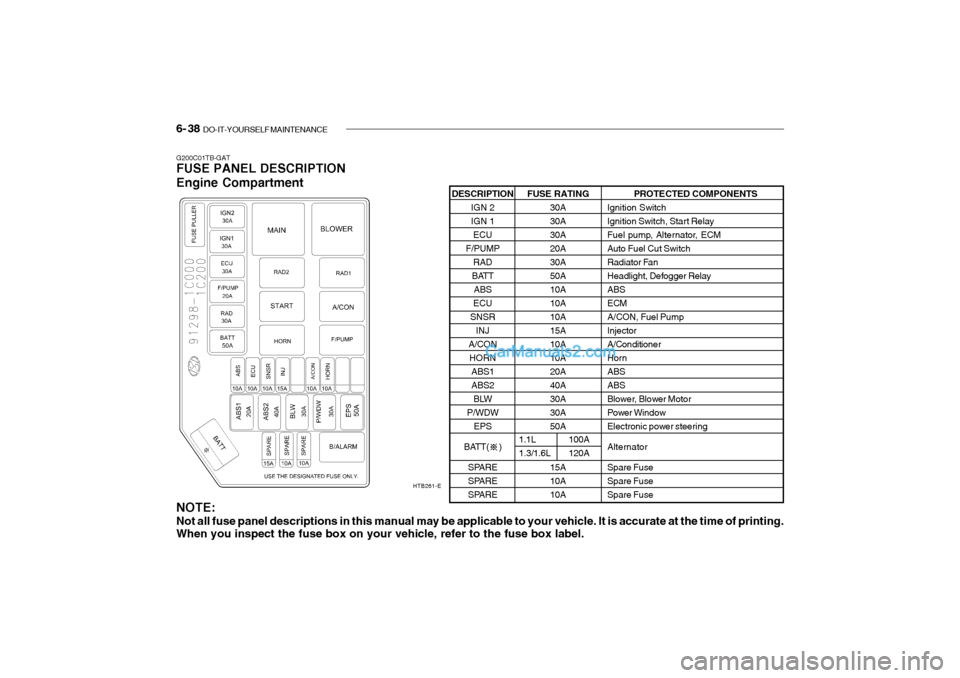
6- 38 DO-IT-YOURSELF MAINTENANCE
G200C01TB-GAT FUSE PANEL DESCRIPTION Engine Compartment
HTB261-EPROTECTED COMPONENTS
Ignition Switch
Ignition Switch, Start Relay
Fuel pump, Alternator, ECM
Auto Fuel Cut Switch
Radiator Fan
Headlight, Defogger RelayABSECMA/CON, Fuel PumpInjectorA/Conditioner
HornABSABS
Blower, Blower Motor
Power Window
Electronic power steering AlternatorSpare Fuse Spare FuseSpare Fuse
FUSE RATING
30A30A30A20A30A50A10A10A10A15A10A10A20A40A30A30A50A 15A 10A10A
DESCRIPTION
IGN 2IGN 1ECU
F/PUMP RAD
BATT ABS
ECU
SNSR INJ
A/CON HORN ABS1ABS2 BLW
P/WDW EPS
BATT( ) SPARE
SPARE
SPARE
NOTE:
Not all fuse panel descriptions in this manual may be applicable to your vehicle. It is accurate at the time of printing. When you inspect the fuse box on your vehicle, refer to the fuse box label.
1.1L 1.3/1.6L 100A120A
Page 241 of 445
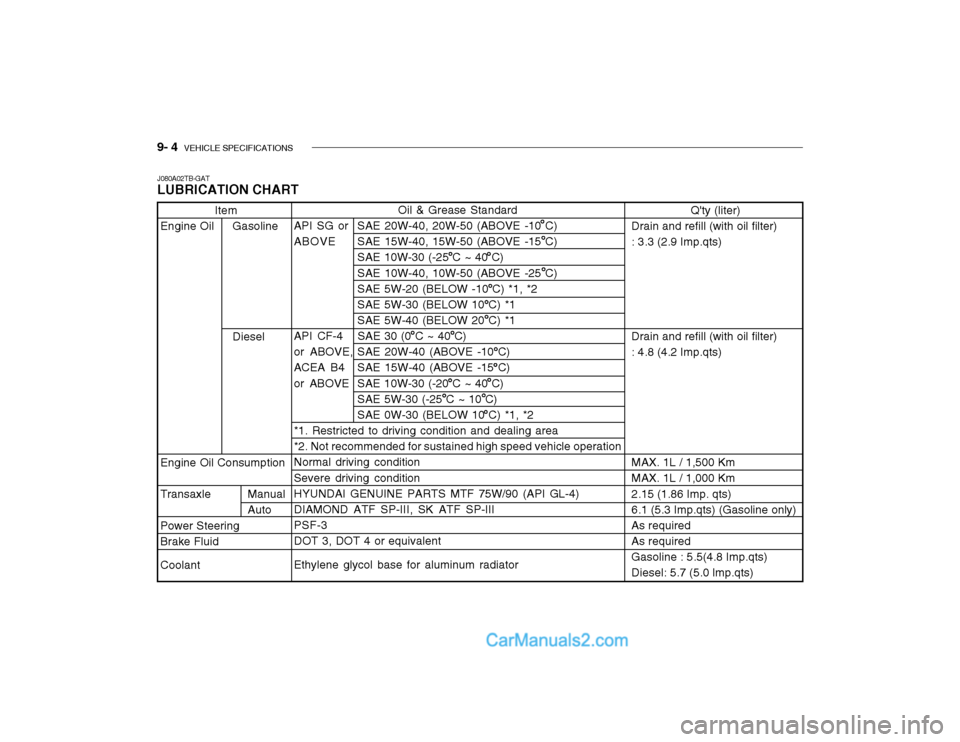
9- 4 VEHICLE SPECIFICATIONS
Oil & Grease Standard
API SG or SAE 20W-40, 20W-50 (ABOVE -10 C) ABOVE SAE 15W-40, 15W-50 (ABOVE -15 C)SAE 10W-30 (-25 C ~ 40 C) SAE 10W-40, 10W-50 (ABOVE -25 C) SAE 5W-20 (BELOW -10 C) *1, *2SAE 5W-30 (BELOW 10 C) *1 SAE 5W-40 (BELOW 20 C) *1
API CF-4 SAE 30 (0 C ~ 40 C)
or ABOVE, SAE 20W-40 (ABOVE -10 C)
ACEA B4 SAE 15W-40 (ABOVE -15 C)
or ABOVE SAE 10W-30 (-20 C ~ 40 C) SAE 5W-30 (-25 C ~ 10 C) SAE 0W-30 (BELOW 10 C) *1, *2
*1. Restricted to driving condition and dealing area*2. Not recommended for sustained high speed vehicle operationNormal driving condition Severe driving condition HYUNDAI GENUINE PARTS MTF 75W/90 (API GL-4)DIAMOND ATF SP-III, SK ATF SP-III PSF-3 DOT 3, DOT 4 or equivalent Ethylene glycol base for aluminum radiator
Item
Engine Oil Gasoline
Diesel
Engine Oil Consumption
Transaxle Manual Auto
Power Steering
Brake Fluid Coolant
J080A02TB-GAT LUBRICATION CHARTQ'ty (liter)
Drain and refill (with oil filter) : 3.3 (2.9 Imp.qts) Drain and refill (with oil filter) : 4.8 (4.2 Imp.qts) MAX. 1L / 1,500 Km MAX. 1L / 1,000 Km 2.15 (1.86 Imp. qts) 6.1 (5.3 Imp.qts) (Gasoline only)As required As required Gasoline : 5.5(4.8 Imp.qts)Diesel: 5.7 (5.0 lmp.qts)
Page 302 of 445
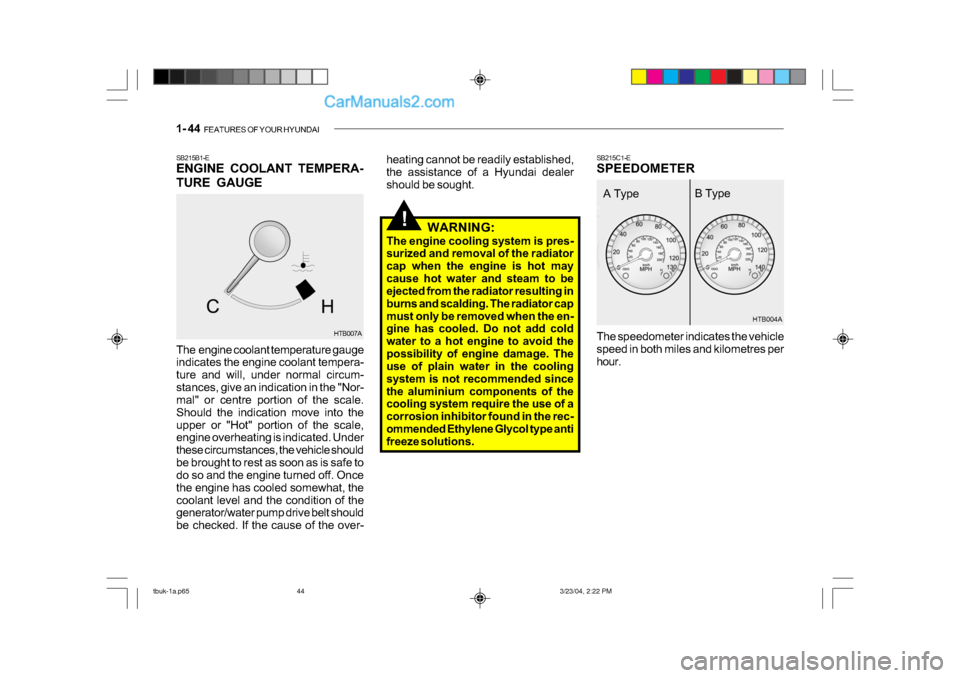
1- 44 FEATURES OF YOUR HYUNDAI
!
SB215B1-E
ENGINE COOLANT TEMPERA-
TURE GAUGE
The engine coolant temperature gauge
indicates the engine coolant tempera-
ture and will, under normal circum-
stances, give an indication in the "Nor-
mal" or centre portion of the scale.
Should the indication move into the
upper or "Hot" portion of the scale,
engine overheating is indicated. Under
these circumstances, the vehicle should
be brought to rest as soon as is safe to
do so and the engine turned off. Once
the engine has cooled somewhat, the
coolant level and the condition of the
generator/water pump drive belt should
be checked. If the cause of the over- SB215C1-E
SPEEDOMETER
HTB007A
heating cannot be readily established,
the assistance of a Hyundai dealer
should be sought.
HTB004A
The speedometer indicates the vehicle
speed in both miles and kilometres per
hour.
WARNING:
The engine cooling system is pres-
surized and removal of the radiator
cap when the engine is hot may
cause hot water and steam to be
ejected from the radiator resulting in
burns and scalding. The radiator cap
must only be removed when the en-
gine has cooled. Do not add cold
water to a hot engine to avoid the
possibility of engine damage. The
use of plain water in the cooling
system is not recommended since
the aluminium components of the
cooling system require the use of a
corrosion inhibitor found in the rec-
ommended Ethylene Glycol type anti
freeze solutions.
A Type B Type
tbuk-1a.p65
3/23/04, 2:22 PM
44
Page 322 of 445
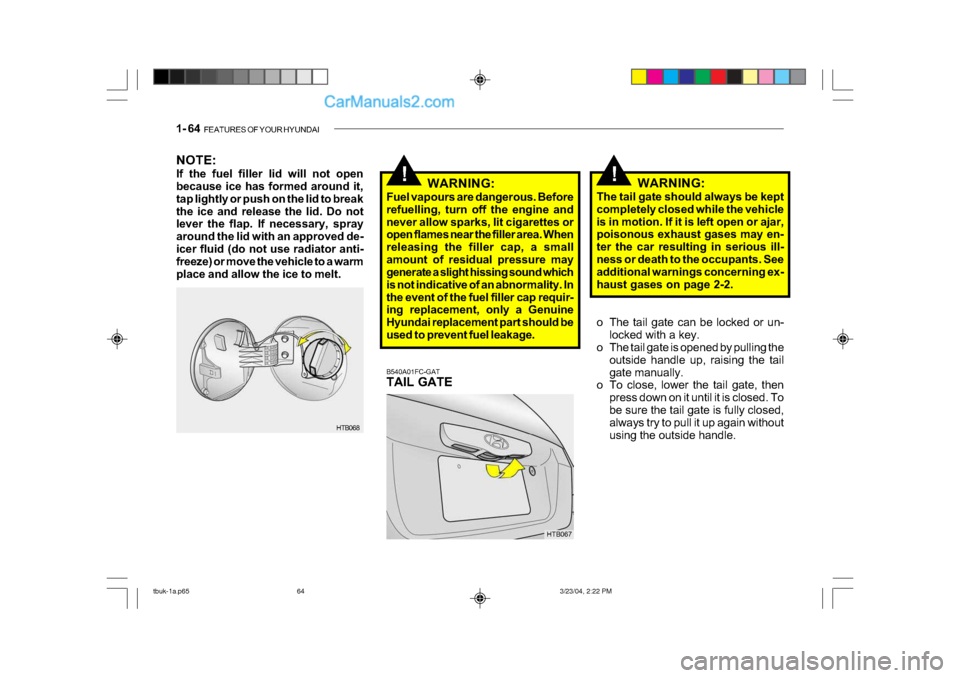
1- 64 FEATURES OF YOUR HYUNDAI
!!
NOTE:
If the fuel filler lid will not open
because ice has formed around it,
tap lightly or push on the lid to break
the ice and release the lid. Do not
lever the flap. If necessary, spray
around the lid with an approved de-
icer fluid (do not use radiator anti-
freeze) or move the vehicle to a warm
place and allow the ice to melt.
B540A01FC-GAT
TAIL GATE
HTB067WARNING:
The tail gate should always be kept
completely closed while the vehicle
is in motion. If it is left open or ajar,
poisonous exhaust gases may en-
ter the car resulting in serious ill-
ness or death to the occupants. See
additional warnings concerning ex-
haust gases on page 2-2.
HTB068 WARNING:
Fuel vapours are dangerous. Before
refuelling, turn off the engine and
never allow sparks, lit cigarettes or
open flames near the filler area. When
releasing the filler cap, a small
amount of residual pressure may
generate a slight hissing sound which
is not indicative of an abnormality. In
the event of the fuel filler cap requir-
ing replacement, only a Genuine
Hyundai replacement part should be
used to prevent fuel leakage. o The tail gate can be locked or un-
locked with a key.
o The tail gate is opened by pulling the
outside handle up, raising the tail
gate manually.
o To close, lower the tail gate, then
press down on it until it is closed. To
be sure the tail gate is fully closed,
always try to pull it up again without
using the outside handle.
tbuk-1a.p65 3/23/04, 2:22 PM
64